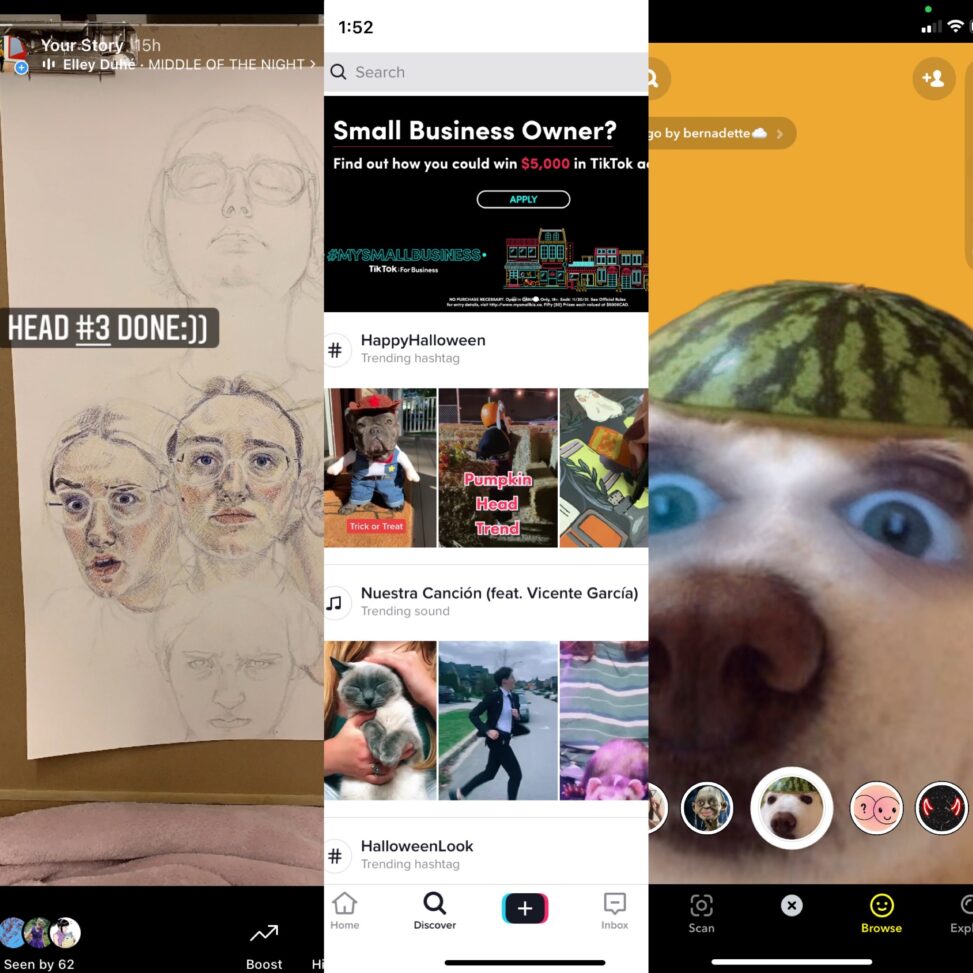Holly Bartels, T00663819
VISA 1500_01
Dr. Terryl Atkins
10/31/21
Assignment 3, Part A
After collecting data for a period of 5 days on my iPhone, via the screen time function, it became apparent that my top three SNS during this period were Instagram, TikTok and Snapchat. My use of TikTok for consumption places it under the entertainment category, whereas Snapchat was used for interpersonal communication and Instagram, a combination of the two. Of my total screen time usage of an alarming 32 hours and 27 minutes, the most amount of time was allocated to Instagram (5 hours and 51 minutes). During this duration, Instagram was used for communicating with classmates, consuming, and sharing content made by others as well as creating my own on the story function. Coming in second place was TikTok with 5 hours and 22 minutes, no conversing or posting, just purely consuming and sharing premade content with others on the platform. Far behind the other two was Snapchat, with 3 hours and 16 minutes and was used to converse with family, friends, and classmates on a variety of topics.
As with any Social Networking Site, there are positives and negatives for these. There are a few shared positives between all three platforms, one being that you can communicate with others around the world free of charge and not restricted by area code. Instagram and TikTok allow artists and business owners to promote their work to a larger audience compared to word of mouth in their local area. Despite the positiveness of feeling connected anywhere, there are still negatives lurking. With Instagram being a branch from Facebook, the ‘look at me’ lifestyle has carried over, and this behaviour of editing ourselves to look appealing to the world “has been linked to body dissatisfaction and body surveillance among women,” (Tiggemann and Anderberg, par. 3). The creation of the ‘like’ function on SNS’s also created health issues mentally and emotionally, leading to Canada testing out the removal of the ‘like’ tally under Instagram posts back in 2019, allowing only the original poster to see the total, (Wilson, par. 3). A common con among all three is filters. Filters, although some are designed for humour, many are used as a virtual cosmetic surgery to make our faces look, for the moment, like the current beauty standard.
Instagram’s application is really an accumulation of the functions used in both TikTok and Snapchat. That evolution will help the platform stay relevant longer.
With the global pandemic aiding in the surge of SNS uses around the world to replace majority of our in-person interactions, we find this new level of reliability, and I am no different. Compared to my use of them in quarantine, this time round they are being used ‘passively’ with little posting and the majority being consumption and sharing. This ‘passive’ approach, as mentioned by Choi and Choung, may be used to simply expel the boredom that we faced during lockdown, (par. 5). But this boredom and distraction did not end with lockdown, and now we are led to the study of how students might be affected by this increase of use. The multitasking that is born from the divided and shorter attention span is seen to have a negative effect on students’ performances and overall GPA, (Tafesse, par. 15). With the expectation that technology will continue to develop, this problem will persist.
References
Choi, Mina, and Hyesun Choung. “Mediated Communication Matters during the COVID-19 Pandemic: The Use of Interpersonal and Masspersonal Media and Psychological Well-Being.” Journal of Social and Personal Relationships, vol. 38, no. 8, Aug. 2021. SAGE journals, Doi: https://doi.org/10.1177/02654075211029378 . Accessed 30 October 2021.
Tafesse, Wondwesen. “The Effect of Social Networking Site Use on College Students’ Academic Performance: The Mediating Role of Student Engagement.” Education and Information Technologies, vol. 25, Apr. 2020. Springer Link, Doi: https://doi.org/10.1007/s10639-020-10162-y . Accessed 30 October 2021.
Tiggemann, Marika, and Isabella Anderberg. “Social Media Is Not Real: The Effect of ‘Instagram vs Reality’ Images on Women’s Social Comparison and Body Image.” New Media & Society, vol. 22, no. 12, Dec. 2020. SAGE journals, Doi: https://doi.org/10.1177/1461444819888720 . Accessed 30 October 2021.
Wilson, Kate. “Instagram Removing Likes from Photos in Canada in Controversial Test.” The Georgia Straight, Vancouver Free Press Corp., 1 May 2019, https://www.straight.com/tech/1234736/instagram-removing-likes-photos-canada-controversial-test . Accessed 30 October 2021.
